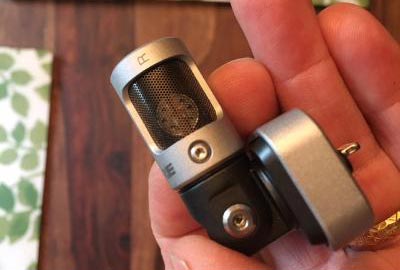 “It’s soooo cute!” is usually a phrase I hear when people meet the family dog (he is cute). It’s not something I typically expect to hear with respect to microphones. I heard that phrase more than once when showing people the new Shure MV88.
“It’s soooo cute!” is usually a phrase I hear when people meet the family dog (he is cute). It’s not something I typically expect to hear with respect to microphones. I heard that phrase more than once when showing people the new Shure MV88.
What could be better for an audio geek than being able to get your hands on some of the latest gear and put it through its paces? Albeit, it can be a bitter-sweet situation when I have to send back products that I grow to REALLY like. I foresee this exact situation arising when I have to send the Shure MV88 iOS Condenser Microphone back to Best Buy.
Full Disclosure
I’ll be right upfront on this post: I REALLY like this microphone. In fact, as I’m typing this, I’m rehearsing the speech to justify acquiring my very own MV88. In reality, it shouldn’t actually be that hard given the price of the microphone (MSRP of CDN$ 219).
It’s not by any means the mic to rule all mics—it’s all a matter of taste and perspective. There are a lot of mics that would be a better choice in a lot of different situations. In the studio, I’d most likely be setting up anything but this mic. But the studio is not necessarily the locale for which this microphone was designed. Shure has put together a quality, flexible microphone/recording solution that allows practically anyone to record anything, anywhere using an iOS device.
 Small Package and So Much Good
Small Package and So Much Good
I got to see this microphone along with the other MOTIV line of products that Shure introduced this year at the NAMM show. These products were something I was hoping that I’d get my hands on.
The Shure MV88 is an MFi (Made For iOS) Mid-Side microphone that connects to the Lightning Connector on a compatible Apple iPhone, iPod or iPad device. It measures 67 mm x 25 mm x 35 mm (H x W x D) and weighs 40.5 g (1.4 oz).
There are two small-diaphragm transducer capsules in the microphone housing: a cardiod condenser (1cm) and a bi-directional condenser cartridge. The MV88 can capture two bit depth/sample rate combinations: 16 bit/ 44.1 kHz (CD quality) and 24 bit / 48 kHz (DVD quality).
The MV88 has a rated frequency response of 20 Hz to 20 kHz and a maximum sound pressure level rating of 120 dB SPL.
The MV88 unit contains not only the microphone and pre-amplification circuitry, but also all of the DSP (digital signal processing) capabilities that can be accessed through the free Shure Motiv app. This is great for two reasons:
- off-loading of the DSP functionality eases the processing load on your iOS device
- The settings you make to the MV88 through the MOTIV app remain persistent on the microphone—allowing you to set processing and microphone configuration options that will persist on the device if it is used in another app or even on another device.
Total Control
 You don’t necessarily need the app in order to use the MV88, but it opens up a virtual pandora’s box of tools and functionality. The Motiv app is quite intuitive and provides you access to a lot of features:
You don’t necessarily need the app in order to use the MV88, but it opens up a virtual pandora’s box of tools and functionality. The Motiv app is quite intuitive and provides you access to a lot of features:
- Save to compressed formats (ALAC, AAC 96, 128, 256)
- High-resolution metering
- Preset modes to automatically adjust gain, equalization, and compression
- 5-band equalizer
- Limiter
- Compressor
- Polar pattern selection (stereo, cardioid, bidirectional, raw mid-side)
- Adjustable stereo width (60, 75, 90, 105, 120, 135 degrees)
- Wind noise reduction: Low-frequency cutoff filter to eliminate rumble caused by environmental noise
- Left-right channel swap: Flips the left and right audio channels to match video that is recorded when the microphone is reversed in certain phone/tablet positions.
Mysterious Mid-Side Magic
Now bear with me, this is going to get a bit into the geek-realm.
The Mid-Side stereo microphone technique (related to, but different from Mid-Side processing capabilities in some plug-ins) is arguably the least understood, and, at first, the most intimidating method of recording stereo. The mid-side stereo microphone technique was devised by EMI engineer Alan Blumlein and the technique was patented in 1933.
The mid-side technique offers a lot of advantages over other techniques in that it allows you to adjust the width of the stereo field. Mid-side also offers built-in mono compatibility. If your stereo recording gets collapsed to mono, the direct (mid) signal is the only thing left with no phase artifacts that can be found in other stereo microphone techniques.
The technique involves one cardiod microphone (this can be hypercardiod, omni or even bi-directional in some cases) that serves as the mid (center or focus) component and a bi-directional (or “figure 8”) microphone that serves as the side component of the moniker “Mid-Side.” The technique is confusing in that it is not as intuitive as other stereo microphone techniques (X-Y, spaced pair, ORTF…): Two similar microphones recording the respective sides (left and right) of the stereo image.
 The mid (cardiod) microphone is set up so that it is pointing at the sound source. The side (bidirectional) microphone is set up as close as possible to the mid microphone with its diaphragm pointing at a 90-degree angle to the diaphragm of the mid microphone.
The mid (cardiod) microphone is set up so that it is pointing at the sound source. The side (bidirectional) microphone is set up as close as possible to the mid microphone with its diaphragm pointing at a 90-degree angle to the diaphragm of the mid microphone.
Setting up the microphones is quite simple. The confusing part comes in setting up the capture and/or playback in order to realize the stereo image. The signal of the side microphone signal (or recorded track) needs to be duplicated and have its polarity flipped 180 degrees. You end up with three channels:
- a center (mid) channel
- a positive polarity side channel
- a negative polarity side channel
 The stereo image comes from taking advantage of a phenomenon called constructive and destructive phase coherence. The two sides of the stereo image come from the combination of the mid microphone and a respective copy of the side channel:
The stereo image comes from taking advantage of a phenomenon called constructive and destructive phase coherence. The two sides of the stereo image come from the combination of the mid microphone and a respective copy of the side channel:
- Mid + positive polarity side channel
- Mid + negative polarity side channel
Adjusting the relative volumes of the mid versus the side channels will increase or decrease the perceived spread of the stereo image.
MV88 in the Wild
Now, I hope I haven’t scared you off because Shure has made this more simple for you in that you don’t really have to worry about setting up and/or processing the mid-side microphones to realize a stereo image … but that option is there if you’d like.
 The MOTIV app lets you take advantage of the two different types of microphone capsules in that you can record:
The MOTIV app lets you take advantage of the two different types of microphone capsules in that you can record:
- a standard Left-Right stereo image (the app takes care of the Mid-Side processing for you),
- a mono cardiod signal,
- a mono bi-directional signal or
- a raw Mid and Side signal you can process on your own.
The app gives you the ability to engage wind-reduction processing (a high-pass filter that attempts to block out low-frequency rumble), add a limiter, two compressor settings, swap left-right channels and adjust EQ via a 5-band graphic Equalizer.
I took this little guy everywhere I could and recorded with it as much as I could. Refer to the attached clip for more details.
As I mentioned in the opening, the quality of the audio recorded from this microphone is very, very good.
Is it going to replace microphones in your studio? No. But as I mentioned above, that is not really what this microphone is intended for. It’s a convenient option for people to capture quality recordings wherever and whenever they may be.
Is it going to replace my Zoom H5? Perhaps. You’re not always near a studio or have the appropriate gear with you when an opportunity to record audio presents itself.
 Because of the form factor, I was able to pack this microphone along with me without a second thought. It fits into a jacket or cargo-shorts pocket with more than enough room to spare.
Because of the form factor, I was able to pack this microphone along with me without a second thought. It fits into a jacket or cargo-shorts pocket with more than enough room to spare.
I already have my phone, so when a situation arose, where I thought, “This sound would be cool to capture right now,” I didn’t have to regret that I didn’t have any equipment with me.
Pulling out my phone, plugging in the microphone and launching the app took a matter of seconds and I was off. The presets on the MOTIV app give you a great starting point with which to just begin to record and not have to worry.
Being able to easily pivot and rotate the microphone in relation to my iPhone was very handy. I could adjust it to use the phone in vertical or horizontal and landscape or portrait modes.
The app saves the audio files as PCM WAV format, but you have the option to save copies as AAC (96, 128 and 256 kbps) or Apple Lossless.
Spilling the Bowl of Cherries
Now, it’s time to show you that rose-coloured glasses weren’t always being worn throughout this review. I do have a wishlist of things that would have made everything rainbows and unicorns, although some of them are probably beyond Shure’s control.
 Physical Vibrations Easily Picked Up: The mobility aspect of the phone / microphone coexistence is awesome, but I found that there has been very little done to try and isolate the microphone from physical vibrations. Whether I was holding the phone or had it set down on a table, the physical vibrations of movements, bumps, screen gestures were very easily picked up by the microphone. There’s a small, elevated black plastic bezel around the Lightning connector, but it doesn’t seem to do much for physical noise.
Physical Vibrations Easily Picked Up: The mobility aspect of the phone / microphone coexistence is awesome, but I found that there has been very little done to try and isolate the microphone from physical vibrations. Whether I was holding the phone or had it set down on a table, the physical vibrations of movements, bumps, screen gestures were very easily picked up by the microphone. There’s a small, elevated black plastic bezel around the Lightning connector, but it doesn’t seem to do much for physical noise.- Physical Design Issues: The base of the microphone significantly protrudes in front of and behind the screen/back of iPhones, iPods or iPads. I saw this as a potential for problems when trying to lay coupled devices flat (causing undue stress on the lightning connection) and the possibility of decoupling the two devices inadvertently by catching the microphone platform on some foreign object.
- Disabling Headphone Microphone: Shure includes a small mini jack extension cord with the microphone to use in conjunction with your headphones. The reason for its inclusion becomes apparent when you attempt to plug in any TRRS headphone (with microphone and buttons) in order to monitor the microphone signal as the headphone microphone overrides the MV88. This is most likely an Apple hardware default (out of Shure’s control), but it would be so much more convenient if one could simply disable the headphone mic and be able to select the audio source.
- RF Interference Headaches: Whenever you start the MOTIV app, a handy reminder pops up to remind you to engage the airplane mode of your device. It would be great to be able to set this as an automatic default action whenever you plugged the mic in or at least start the app. There were a couple of times when the enthusiasm of capturing the moment caused me to neglect doing this and the RF interference of your phone retrieving various signals can wreak serious audio havoc on your recordings.
- Transferring Files from the Device: I would love to be able to do a mass export of the recordings I made using the MV88 and the MOTIV app. Currently the app only allows you to transfer (via wireless methods) each clip individually. After a day of recording many clips, this can get very tedious, very quickly.
***EDIT*** Shure let me know that there IS in fact a method of uploading your recordings enmass through the iTunes application when you connect your iOS device to your computer: How to export or share recordings from the Motiv app on iTunes. - DSP Transparency: I’d love it if Shure published the general parameters of what the DSP functions on the MOTIV app are doing. I understand the need to keep things streamline and simple, and exposing more controls would make things much more complicated for the end user experience. The limiter, the compressor, the wind reduction and EQ capabilities are all very useful, but it would be great to be able to know, in general terms, what parameters specific to those processes are being applied to the sound.
Audio Examples
I’ve uploaded a few examples of what I recorded with the MV88:
 Final Thoughts
Final Thoughts
I can’t speak to how the MV88 and MOTIV app compare to other devices on the market (IK iRig, Rhode iXY or Zoom’s iQ line), but I can say that I was very impressed with the performance of the microphone and accompanying app.
I wouldn’t go so far as to say it’s a revolutionary product, but perhaps evolutionary? It certainly has enabled me to evolve when and where I can record with very little effort. Even after living with the MV88 for a few weeks, I still have that kid-inspired new-toy euphoria when picking it up and toting it along with me. It’s been a while since I’ve experienced that.
These will soon be available at Best Buy where you will find a wide assortment of recording equipment, musical instruments and accessories.



Thanks for the honest review.
Comments are closed.